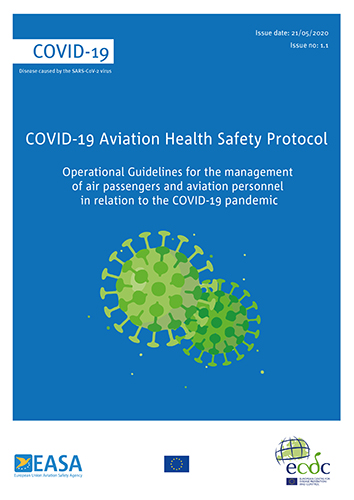During the COVID-19 crisis, EASA has worked to address aviation stakeholders’ needs as efficiently as possible. It has provided the aviation industry with guidance on the measures necessary to implement the safe resumption of operations. The COVID-19 Aviation Health Safety Protocol, jointly developed by EASA and the European Centre for Disease Prevention and Control (ECDC), has become the industry reference for a coordinated approach to restoring air travel. Report by Eduard Ciofu
As I live close to Cologne-Bonn Airport (CGN), my “home office” window offers a good view on the approach path to RWY25 and from time to time I see the silhouettes of transport aeroplanes. Several times a day I hear the reassuring sound of jet engines as the “heavies” climb out in a left hand turn, bound for transatlantic destinations. For the casual observer, aviation is still in business: but only because CGN is home to several express companies, perhaps the only sector to emerge relatively unscathed from this crisis. For most, the situation is dire, with some 25,000 flights missing from the European skies every day in April and May 2020. “Unprecedented crisis” is a fitting description.

The COVID-19 Aviation Health Safety Protocol, jointly developed by EASA and the European Centre for Disease Prevention and Control (ECDC), has become the industry reference for a coordinated approach to restoring air travel.
EASA was quick to identify the threat posed by COVID-19 and issue a Safety Information Bulletin (SIB) with measures to protect passengers and front-line personnel. As the outbreak intensified, mandatory actions were specified, requiring enhanced aircraft disinfection and carriage of protective equipment. EASA issued detailed guidance on crew management. As Europe and other parts of the world started to shut down, EASA focused on ensuring business continuity and enabling aviation to fight the pandemic.
EASA published guidance on the safe transport of cargo in passenger aeroplanes and on the issuance of exemptions from fatigue regulations, so that flights could serve states where crew accommodation was no longer available due to quarantine measures. Many other similar actions were taken, addressing training and checking of personnel, aircraft storage, installation of isolating partitions and helicopter medical services. Even in these extenuating circumstances aviation played its part, bringing in vital medical supplies or repatriating Europeans stranded in other parts of the world.
Whilst the pandemic is still far from over, the situation in Europe shows signs of normalisation, and commercial aviation is taking off again. In preparation, EASA launched Project RNO (Return to Normal Operations), bringing together representatives from most prominent industry associations including ACI EUROPE, personnel associations and Member States. The most pressing need was the lifting of travel restrictions. Aviation is the business of connectivity and is intrinsically cross-border. A coordinated approach for public health measures in aviation was seen as the catalyst of a swift recovery, as a disharmonised situation would create difficulties for passengers and airlines and undermine public trust. EASA therefore partnered with its sister Agency, ECDC (European Centre for Disease Prevention and Control) to develop the COVID-19 Aviation Health Safety Protocol, a set of Guidelines for the management of air passengers and aviation personnel, both in the airport and on board of the aircraft. The focus now is to ensure their proper implementation both within Europe and beyond.
Getting aviation back in business requires a joint and coordinated effort from the entire sector. The recovery will not succeed if safety needs are neglected, and this is the underlying leitmotiv of Project RNO. EASA will focus on ensuring that aviation personnel are trained to the highest competence standards and that aircraft are airworthy (with special emphasis on their storage and subsequent return to service).
Aviation built its safety record by excelling at identifying and managing risk. This competence will need to be reinforced, so that SMSs across the sector will be robust, resilient and particularly adept at identifying emerging risks generated by the COVID-19 crisis. This particular topic is a specific focus area within Project RNO. EASA is also designing tools and models that should help the sector to better control epidemiological risk. We should indeed not let a good crisis go to waste but rather make use of it, to make sure we will be better prepared in future.
This crisis is shared by everybody (in aviation) and EASA is committed to doing its part to resolve it.
Eduard Ciofu is Air Operations Standards Section Manager, EASA.







